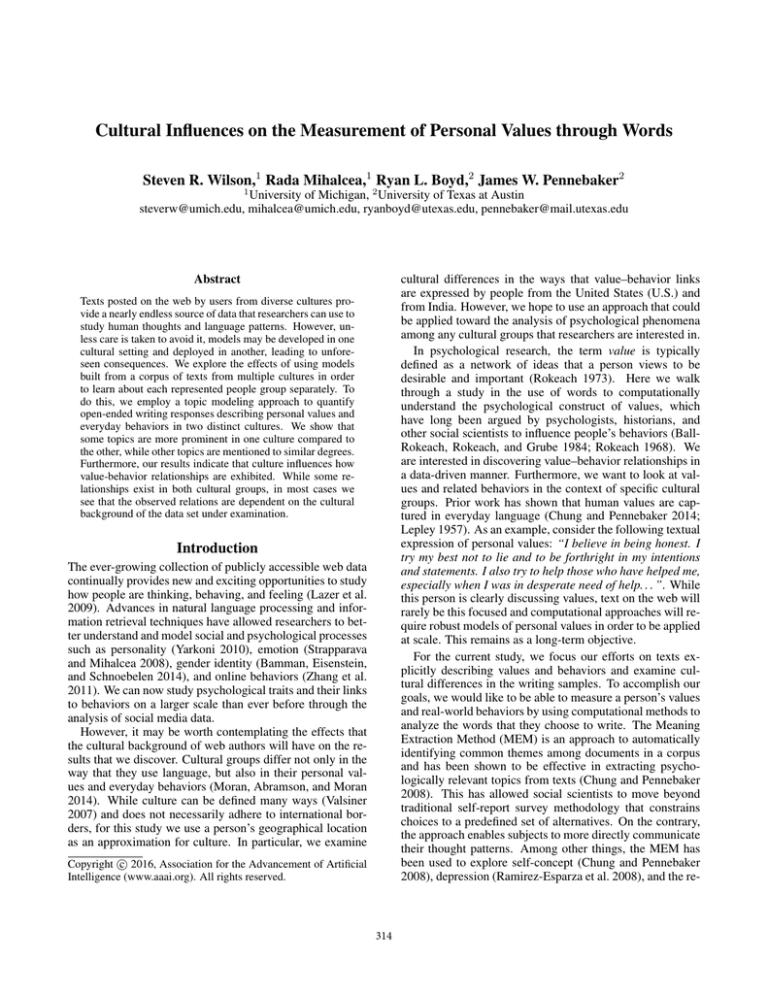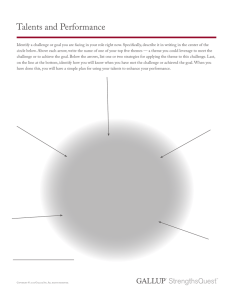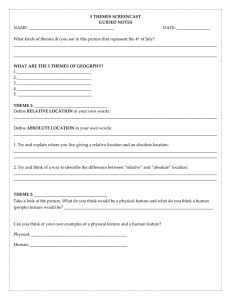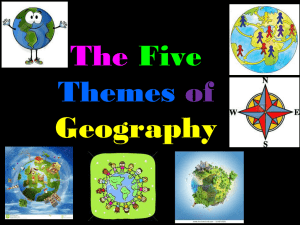
Cultural Influences on the Measurement of Personal Values through Words
Steven R. Wilson,1 Rada Mihalcea,1 Ryan L. Boyd,2 James W. Pennebaker2
1
University of Michigan, 2 University of Texas at Austin
steverw@umich.edu, mihalcea@umich.edu, ryanboyd@utexas.edu, pennebaker@mail.utexas.edu
cultural differences in the ways that value–behavior links
are expressed by people from the United States (U.S.) and
from India. However, we hope to use an approach that could
be applied toward the analysis of psychological phenomena
among any cultural groups that researchers are interested in.
In psychological research, the term value is typically
defined as a network of ideas that a person views to be
desirable and important (Rokeach 1973). Here we walk
through a study in the use of words to computationally
understand the psychological construct of values, which
have long been argued by psychologists, historians, and
other social scientists to influence people’s behaviors (BallRokeach, Rokeach, and Grube 1984; Rokeach 1968). We
are interested in discovering value–behavior relationships in
a data-driven manner. Furthermore, we want to look at values and related behaviors in the context of specific cultural
groups. Prior work has shown that human values are captured in everyday language (Chung and Pennebaker 2014;
Lepley 1957). As an example, consider the following textual
expression of personal values: “I believe in being honest. I
try my best not to lie and to be forthright in my intentions
and statements. I also try to help those who have helped me,
especially when I was in desperate need of help. . . ”. While
this person is clearly discussing values, text on the web will
rarely be this focused and computational approaches will require robust models of personal values in order to be applied
at scale. This remains as a long-term objective.
For the current study, we focus our efforts on texts explicitly describing values and behaviors and examine cultural differences in the writing samples. To accomplish our
goals, we would like to be able to measure a person’s values
and real-world behaviors by using computational methods to
analyze the words that they choose to write. The Meaning
Extraction Method (MEM) is an approach to automatically
identifying common themes among documents in a corpus
and has been shown to be effective in extracting psychologically relevant topics from texts (Chung and Pennebaker
2008). This has allowed social scientists to move beyond
traditional self-report survey methodology that constrains
choices to a predefined set of alternatives. On the contrary,
the approach enables subjects to more directly communicate
their thought patterns. Among other things, the MEM has
been used to explore self-concept (Chung and Pennebaker
2008), depression (Ramirez-Esparza et al. 2008), and the re-
Abstract
Texts posted on the web by users from diverse cultures provide a nearly endless source of data that researchers can use to
study human thoughts and language patterns. However, unless care is taken to avoid it, models may be developed in one
cultural setting and deployed in another, leading to unforeseen consequences. We explore the effects of using models
built from a corpus of texts from multiple cultures in order
to learn about each represented people group separately. To
do this, we employ a topic modeling approach to quantify
open-ended writing responses describing personal values and
everyday behaviors in two distinct cultures. We show that
some topics are more prominent in one culture compared to
the other, while other topics are mentioned to similar degrees.
Furthermore, our results indicate that culture influences how
value-behavior relationships are exhibited. While some relationships exist in both cultural groups, in most cases we
see that the observed relations are dependent on the cultural
background of the data set under examination.
Introduction
The ever-growing collection of publicly accessible web data
continually provides new and exciting opportunities to study
how people are thinking, behaving, and feeling (Lazer et al.
2009). Advances in natural language processing and information retrieval techniques have allowed researchers to better understand and model social and psychological processes
such as personality (Yarkoni 2010), emotion (Strapparava
and Mihalcea 2008), gender identity (Bamman, Eisenstein,
and Schnoebelen 2014), and online behaviors (Zhang et al.
2011). We can now study psychological traits and their links
to behaviors on a larger scale than ever before through the
analysis of social media data.
However, it may be worth contemplating the effects that
the cultural background of web authors will have on the results that we discover. Cultural groups differ not only in the
way that they use language, but also in their personal values and everyday behaviors (Moran, Abramson, and Moran
2014). While culture can be defined many ways (Valsiner
2007) and does not necessarily adhere to international borders, for this study we use a person’s geographical location
as an approximation for culture. In particular, we examine
c 2016, Association for the Advancement of Artificial
Copyright Intelligence (www.aaai.org). All rights reserved.
314
lationships between personal values and everyday behaviors
(Boyd et al. 2015). However, these studies were either carried out exclusively within the U.S., or no location based
demographic information was reported. It is unclear how
the claims made can be extended to other cultural groups or
how the results might change given a culturally different set
of subjects.
Understanding what role culture plays in the interpretation of our models’ results will inform not only values research, but should be taken into consideration whenever researchers are building models of language generated by people from different cultures. Previously, we have shown that
the MEM provides a broad and comprehensive view of how
values and behaviors are related (Boyd et al. 2015). We now
set out to show to what extent we will arrive upon different results when applying the same models to texts whose
authors differ culturally.
converted into a binary vector indicating the presence of a
given word with a value of 1 and the absence of a word with
a 0. Based on the notion that word co-occurrences can lead
to psychologically meaningful word groupings, we then perform principal components analysis on the correlation matrix of these document vectors, and applied the varimax rotation. The top 15 components were kept and became the set
of themes, or topics, that categorize the set of content words
in the corpus. The number of themes was chosen for topical interpretability and slight variations are possible while
reaching the same general conclusions. Any word with a
factor loading of at least .2 for a particular component is retained as part of the theme, while words with loadings of
less than -.2 are also kept and used to quantify text that is
opposed to the particular theme. Let ft (w) be the factor
loading of the word w for the new topic t. We then define
the membership relation for a word w to a theme t:
⎧
if ft (w) > .2,
⎨1
m(t, w) = −1 if ft (w) < −.2,
⎩
0
otherwise.
Data and Method
We first sought to understand the types of things people from
each culture generally talk about when asked about their values and behaviors. To do this, we collected a corpus of freeresponse writings from U.S. and India respondents. The authors of the texts in our corpus were asked to reflect upon
their own personal values for a set amount of time (at least
six minutes), and they also spent some time writing about
things that they had done in the past week. These data come
from two sections of a social survey that was designed using
Qualtrics survey software and distributed via Amazon Mechanical Turk. In order to guarantee an adequate amount of
text for each user, we only retained surveys in which respondents wrote at least 50 words in each of the writing tasks and
each essay was manually checked for coherence. Additionally, multiple “check” questions were placed throughout the
survey to identify those people who were not paying close
attention to the instructions, and we do not use any part of
the survey from those who missed these questions. After this
filtering process, we chose the maximum number of surveys
that would still allow for an equal balance of data from each
country. Since there were more valid surveys from the U.S.,
a random subsample was drawn from the larger set of surveys. The result is 209 surveys from each culture, or 418
surveys in total, each with both value and behavior writing
components.
In the set of surveys from India, 36% of respondents are
female and 55% reported being between 26 and 34 years old.
All but 4% have completed some college education. For the
those from USA, 63% are female and 38% were between the
ages of 35 and 54 (more than any other age range). 88% have
had some college education. We acknowledge that some of
these other demographic differences between the two groups
may also be contributing to any country-based cultural differences observed.
Each of the text samples was preprocessed using the
Meaning Extraction Helper (Boyd 2014). This software
lemmatizes the words in each document, and additionally
removes common stopwords, rare words (those used in less
than 5% of documents), and function words, as our analysis
is focused on content words. Each of the documents is then
To measure the degree to which a particular topic is used
more by one cultural group, we use the following definition
of Culture Ratio (CR) for a topic t:
U
u s(t, du ) /|U |
CRt (U, I) = I
i s(t, di ) /|I|
where U is the set of all respondents from USA, I is the
set of respondents from India, dx is the relevant document
written by respondent x, and the score function s is:
d
m(t, w)
s(t, d) = w
,
|d|
assuming that a document is an iterable sequence of words.
This score is essentially a normalized count of words in a
document that belong to a particular theme minus any words
that were found to be in opposition to that theme (those
words for which m(t, w) = −1). Thus, the CR score simply summarizes the relative usage of words in a given topic
by each of the two cultures under consideration. Values of
CRt > 1 indicate prevalence of that topic in the U.S., while
scores less than 1 will be achieved by topics that are more
commonly used by authors from India.
Results
We use the approach described in the previous section to
generate themes from our corpus. Table shows the themes
extracted from the values writing samples from both cultures, and Table shows the behavior themes. The theme
names are manually assigned and are only for reference purposes; each theme is itself a collection of words with scores
of either +1 or -1. For each theme, some sample words are
given along with the CRt for that theme. Note that each
word can appear in more than one theme.
Even when using the same set of topics, we see cultural differences coming into play. CR scores for the value
315
Theme
Hard Work
Financial
Respect
Faith
Understanding
Honesty
Familial Love
Relationships
Sharing Thoughts
Caring
Positivity
Rule Following
Family Support
Decision Making
Peaceful
Example Words
job, work, hard
spend, money, time
moral, respect, person
faith, god, belief
understand, teach, right
honest, truth, sure
love, family, child
friend, family, people
see, speak, mind
compassion, kind, equal
happy, feeling, great
rule, follow, society
support, provide, husband
decision, future, consider
human, peace, respect
CRt
1.44
1.31
1.24
1.23
1.21
1.14
1.04
0.96
0.95
0.84
0.76
0.73
0.72
0.71
0.60
to compute the Pearson correlation coefficient between any
two themes. In order to ensure that correlations are not inflated by the presence of the same word in both themes, we
first remove words that appear in any values writing theme
from all behavior writing themes. Then, for each culture,
we compute the relationship between every value theme and
every behavior theme (Table 3, next page). All reported results are significant at α = .05 (two-tailed). Multiple hypothesis testing was addressed by using a series of 10,000
Monte Carlo simulations of the generation of the correlation
matrix.
Analysis of these results shows both cultural similarities
and differences. Interestingly, two of the value-behavior relationships are common across the two cultures: the value
of Hard Work is positively related to behavior Family Chat,
and people who use words indicating a value of Decision
Making also commonly use words from the behavior topic
Work. On the other hand, there are many relationships that
are unique to one of the cultures. In India, for example,
the Peaceful value theme is negatively correlated with Child
Care, but in the U.S., this same value theme is positively
correlated with Meetings. In the U.S., the value of Caring is
negatively related to behavior words in the Work category,
yet the same value in India is negatively correlated with the
Grooming theme.
Table 1: Themes extracted by the MEM from the values essays, along with example words and culture ratio scores.
Theme
Days
Celebration
Leisure
Out Together
Chores
Relaxing
Grooming
Meetings
Family chat
Child Care
Religious
Daily Routine
Work
Commuting
Household
Example Words
monday, tuesday, sunday
drink, party, fun
tv, play, online
bought, together, trip
chore, task, phone
tea, snack, enjoy
tooth, hair, shower
meeting, busy, schedule
chat, family, good
child, dress, bus
temple, pray, visit
breakfast, office, sleep
work, drive, bill
park, walk, daily
laundry, wash, cook
CRt
2.18
1.62
1.41
1.19
1.18
1.16
1.01
1.01
0.92
0.90
0.88
0.82
0.77
0.67
0.60
Conclusions
We have shown how topic models can be used to explore
cultural differences both qualitatively and quantitatively. A
quick glance at Tables 1 and 2 provides a high level descriptive summary of hundreds of writing samples. We were able
to take a set of themes and compute the degree to which a
particular theme is being used in different cultural settings.
The same approach could also be used to understand differences in topic usage between members of any groups that we
defined, such as males and females. Other analyses, such
as the degree of overlap between culture-specific themes,
would also provide a unique look at cultural language differences and similarities. In the future, we also hope to explore
how well these culture-specific themes are able to describe
texts from various cultures in comparison with themes that
were generated using texts from many cultures.
Additionally, we have briefly explored how culture influences the interpretation of topic modeling results. Using the same set of topics, vastly different results were obtained when examining data from different cultural domains.
In particular, value–behavior relationships are not consistent
between the U.S. and India. This result suggests that cultural
biases are at play whenever text from different geographic
locations is being analyzed. Though perhaps intuitive, this
should be remembered when performing large scale studies of user generated text from social media or other online
sources. While this study only focused on small linguistic samples from two countries, further work should explore
a greater number of cultural backgrounds with even larger
data sets.
Table 2: Themes extracted by the MEM from the behavior
essays, along with examplewords and culture ratio scores.
themes show that Hard work, Faith, and Financial are predominately talked about by Americans. Indian authors tend
to use words from the Peaceful, Rule Following, and Decision Making themes. Both cultures mention Familial Love
roughly the same amount of the time. Looking to the behavior themes, we see that authors from the U.S. mention
specific days of the week (Days) more than twice as often as
authors from India. Respondents from U.S. also talk more
about their Leisure time when asked about their past week.
People from India, on the other hand, mentioned taking care
of their Household and Commuting much more than their
American counterparts. Both cultures shared equally about
experiences with Meetings and time spent Grooming.
Next we explore how culture affects discovered value–
behavior relationships. In order to take a look at the relationships between values and everyday behaviors as expressed
in text, we use the previously defined s function to assign a
score to each writing sample for each topic so that the document can now be represented as a vector of topic scores.
Transposing the matrix made up of these vectors provides
easy access to a vector for each topic that contains a series
of scores, one for each writing sample. We use these vectors
316
Child Care
Religious
Relaxing
Meetings
Family Chat
Grooming
Commuting
Out Together
Celebration
Work
Chores
Household
Leisure
Daily Routine
Days
Hard Work
Family Support
Familial Love
Caring
Decision Making
Peaceful
Positivity
Faith
Honesty
Relationships
Understanding
Rule Following
Sharing Thoughts
Respect
Financial
Table 3: Coverage of behavior MEM themes by value MEM themes for two different cultures.
USA: Positive relationship: . Negative relationship: . India: Positive relationship: . Negative relationship: .
Acknowledgments
L.; Brewer, D.; and Christakis, N. 2009. Computational
social science. Science 323(5915):721–723.
Lepley, R. 1957. The Language of Value. New York:
Columbia University Press.
Moran, R. T.; Abramson, N. R.; and Moran, S. V. 2014.
Managing cultural differences. Routledge.
Ramirez-Esparza, N.; Chung, C. K.; Kacewicz, E.; and Pennebaker, J. W. 2008. The psychology of word use in depression forums in english and in spanish: Texting two text analytic approaches. In International Conference on Weblogs
and Social Media.
Rokeach, M. 1968. Beliefs, Attitudes, and Values., volume 34. San Francisco: Jossey-Bass.
Rokeach, M. 1973. The Nature of Human Values, volume 70.
Strapparava, C., and Mihalcea, R. 2008. Learning to identify
emotions in text. Proceedings of the 2008 ACM symposium
on Applied computing - SAC ’08 1556.
Valsiner, J. 2007. Culture in minds and societies: Foundations of cultural psychology. Psychol. Stud.(September
2009) 54:238–239.
Yarkoni, T. 2010. Personality in 100,000 Words: A largescale analysis of personality and word use among bloggers.
Journal of Research in Personality 44:363–373.
Zhang, Y.; Chen, W.; Wang, D.; and Yang, Q. 2011. Userclick modeling for understanding and predicting searchbehavior. Proceedings of the 17th ACM SIGKDD international conference on Knowledge discovery and data mining
1388–1396.
This material is based in part upon work supported by the
National Science Foundation (#1344257), the John Templeton Foundation (#48503), and the Army Research Institute (#W5J9CQ12C0043). Any opinions, findings, and
conclusions or recommendations expressed in this material
are those of the authors and do not necessarily reflect the
views of the National Science Foundation, the John Templeton Foundation, or the Army Research Institute.
References
Ball-Rokeach, S.; Rokeach, M.; and Grube, J. W. 1984.
The Great American Values Test: Influencing Behavior and
Belief Through Television. New York, New York, USA: Free
Press.
Bamman, D.; Eisenstein, J.; and Schnoebelen, T. 2014. Gender identity and lexical variation in social media. Journal of
Sociolinguistics 18(2):135–160.
Boyd, R. L.; Wilson, S. R.; Pennebaker, J. W.; Kosinski, M.;
Stillwell, D. J.; and Mihalcea, R. 2015. Values in words:
Using language to evaluate and understand personal values.
In Ninth International AAAI Conference on Web and Social
Media.
Boyd, R. L. 2014. MEH: Meaning Extraction Helper.
Chung, C. K., and Pennebaker, J. W. 2008. Revealing dimensions of thinking in open-ended self-descriptions: An
automated meaning extraction method for natural language.
Journal of Research in Personality 42:96–132.
Chung, C. K., and Pennebaker, J. W. 2014. Finding values in
words: Using natural language to detect regional variations
in personal concerns. In Geographical psychology: Exploring the interaction of environment and behavior. 195–216.
Lazer, D.; Pentland, A.; Adamic, L.; Aral, S.; Barabasi, A.-
317






